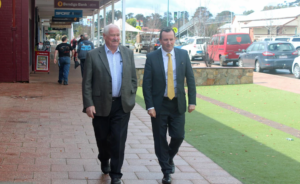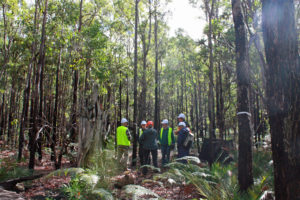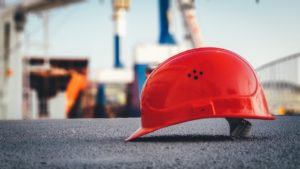Offshore Wind
WHY DO WE NEED TO CONSIDER OFFSHORE WIND IN THE BUNBURY GEOGRAPHE REGION?
Significant opportunity for new jobs and investment to help offset the loss of coal mining and coal fired power production and to keep our kids in the Region
The planned closure of Collie coal mines and coal fired power stations in 2029 will directly affect hundreds of workers and many thousands more indirectly throughout the SW. The offshore wind industry will bring billions of dollars of investment to the Region and a range of job and business opportunities to local towns for the long term.
Bunbury and the surrounding Region has prospered because it has a deep water Port to support our major industries. There will be many opportunities for new trade that will result from the offshore wind industry. There is an opportunity for our Region to become a hub for renewable energy excellence, including the supply and manufacturing of critical minerals and components.
Local suppliers will benefit from working closely with offshore wind developers and the local community and State and Federal Governments to ensure these benefits are realised. BGEA has an active role to play in this regard to ensure our Region is the main beneficiary.
Our industries are decarbonising and need large amounts of reliable renewable power.
Many of our Regions large industries are already experiencing problems with power reliability and there is a high risk of this getting worse as we approach the closure date for the ageing coal fired power assets in Collie. Additionally, the renewable energy transition is happening in our Region. All of our major industries, who are our largest employers (either directly or indirectly) are driven to decarbonise. It is their customers, shareholders and community stakeholders who are demanding this change. This means our Region needs large amounts of renewable energy to not only sustain our current industries but also to attract future investment in new industries. While it is likely that a mix of renewable energy solutions will be needed, offshore wind has the potential to significantly contribute to this required energy need.
Why is Offshore Wind important as a renewable energy option?
Offshore wind is an important component of the energy transition and compliments other forms of green energy.
The size of offshore turbines and the relative strength and reliability of wind in the ocean means that they can generate two or three times more energy per wind turbine than onshore wind for example.
Large onshore wind and solar projects come with their own issues in the SW Region, with land access for infrastructure including powerlines, unpopular with residents and difficult to negotiate. It is also not possible nor sensible to locate all of these renewable projects in areas of low populations such as the wheatbelt. Many new large high voltage powerlines would be needed to transport this energy back to the main electricity grid which is very expensive and come with their own social and environmental impacts. Having the majority of renewable assets in one place is also not good for reliability. If the wind isn’t blowing or the sun isn’t shining in one area, you need generation to come from other areas. Offshore wind also compliments solar generation very well as often the wind is blowing at night.
The concentration of large industries in our Region is a key reason why Geographe Bay has been chosen for consideration of offshore wind over other coastal areas.
The biggest risk to our marine environment is from climate change
Offshore wind will have impacts on the marine environment, and it is essential that detailed studies are undertaken over the next few years to properly understand the risks and then ensure appropriate management measures are designed (including changes to the approved zone and project design if required) to suitably mitigate these risks.
The greater risk to our marine and coastal environments however is from climate change. Ocean warming and sea level rise are just some of the impacts that are already having significant impacts on our marine and coastal environments. The science is globally accepted and the urgency can’t be understated.
Whilst Australia may only be a relatively small contributor to global carbon emissions, McKinsey and Company in an article published in 2022 rightly noted that:
“Our prosperity is founded on trade; and 80% of Australia’s exports are to countries that have made pledges to get to net-zero by 2060. Moreover, the momentum to decarbonise is growing. More than 2,250 companies have committed to meeting science-based targets for emissions reductions—up from just 215 in 2018. Capital markets and consumers are sending similar signals. Australia is an island, but we can’t separate ourselves from global currents”.
It is now the global business community that is largely leading the push to decarbonise and Australia’s ongoing prosperity is reliant on it.
PROCESS TIMELINES
It is important to note that we are just at the start of a long process for the evaluation and approvals of any offshore wind projects. The diagram below summarises the key steps and anticipated timelines. There will be many more opportunities for public input into these proposals as additional information on such things as environmental studies, project design, local job creation and project feasibility becomes available over the next 7 to 8 years.

MAKING A SUBMISSION
The Federal Department of Climate Change, Energy the Environment and Water sought feedback on the suitability of the proposed offshore wind zone as indicated in the diagram below. The public consultation period opened on 20 February 2024 and closed on 3 May 2024.

IMPACTS AND BENEFITS
The following topics were identified in consultation to date as the most common areas of interest in relation to offshore wind. Links to information presented by DCCEEW and other relevant sources are provided under each heading to assist in locating relevant information.
MARINE INTERESTS, USERS AND THE ENVIRONMENT
Marine Users, Interests and the Environment
CARBON ABATEMENT
Frequently Asked Questions – Bunbury
VISUAL IMPACT
https://www.dcceew.gov.au/energy/renewable/offshore-wind/areas/bunbury#toc_6
FISHING
Marine Users, Interests and the Environment
CONSTRUCTION METHODOLOGY
SKILLS AND TRAINING









